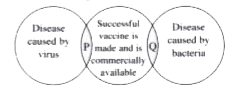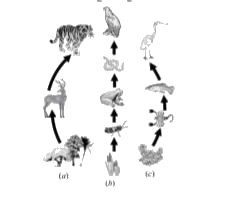Refer to the given dichotomous key and select the correct option.
I. (a) It is categorised as energy giving food . - Go to II
(b) It is categorised as protective food. - Go to III
II. (a) It is soluble in water . - P
(b) It is insoluble in water. - Q
III. (a) It is needed for clotting of blood . - R
(b) It helps in formation of haemoglobin. - S
A
Q could be glucose which is instant source of energy.
B
Deficiency of S causes anaemia characterised by pale body colour, body fatigue, etc.
C
Deficiency of R causes osteoporosis in adults while deficiency of S causes goitre in adults.
D
P could be butter which gives an oily patch on the filter paper.
Video Solution
Text Solution
The correct Answer is:B
According to the given dichotomous key P, Q, R and S could be carbohydrate, fat, calcium and iron respectively. Goitre is caused due to deficiency of iodine. Fats give an oily patch on the filter paper.
|
Updated on:21/07/2023
Related Playlists
- BOOK - SCIENCE OLYMPIAD FOUNDATION CHAPTER - FOOD AND ITS COMPONENTS EXERCISE - ACHIEVERS SECTION (HOTS)5videos
FOOD AND ITS COMPONENTS
- BOOK - SCIENCE OLYMPIAD FOUNDATION CHAPTER - CLASS 6 SAMPLE PAPER FINAL 4EXERCISE - Section C - Science4videos
CLASS 6 SAMPLE PAPER FINAL 4
- BOOK - SCIENCE OLYMPIAD FOUNDATION CHAPTER - NSO MODEL TEST PAPER 01EXERCISE - ACHIEVERS SECTION1videos
NSO MODEL TEST PAPER 01
Similar Practice Problems
- Question 1 - Select One
Go through the given diagram and select the correct option.
 A1-Pith, 3-Intercalary meristemB2-Cortex, 5-Root apical meristemC1-Central cylinder, 5-Lateral meristemD3-Protoderm, 4-Root apical meristem
A1-Pith, 3-Intercalary meristemB2-Cortex, 5-Root apical meristemC1-Central cylinder, 5-Lateral meristemD3-Protoderm, 4-Root apical meristem - Question 1 - Select One
Refer to the given Venn diagram and select the correct option regarding P and Q.
 AP could be small pox whereas Q could be diphtheria.BP could be AIDS whereas Q could be malaria.CP could be common cold whereas Q could be whooping cough.DP could be typhoid whereas Q could be plague.
AP could be small pox whereas Q could be diphtheria.BP could be AIDS whereas Q could be malaria.CP could be common cold whereas Q could be whooping cough.DP could be typhoid whereas Q could be plague. - Question 1 - Select One
Match the column I,II,and III .Select the correct option :
 AA-i-a, B-ii-b, C-iii-cBA-iii-a, B-i-c, C-ii-bCA-ii-b, B-i-c, C-iii-aDA-iii-b, B-i-c, C-ii-a
AA-i-a, B-ii-b, C-iii-cBA-iii-a, B-i-c, C-ii-bCA-ii-b, B-i-c, C-iii-aDA-iii-b, B-i-c, C-ii-a - Question 1 - Select One
Refer to the given dichotomous key and select the correct option regarding P, Q, R, S and T.
I. (a) Genetic material is not enclosed in nucleus. - Go to II
(b) Genetic material is enclosed in nucleus. - Go to III
II. (a) Lacks cell wall. - P
(b) Possesses cell wall. - Q
III. (a) Unicellular organism - R
(b) Multicellular organism - Go to IV
IV. (a) Plant body is sporophytic and water is required for fertilisation. - S
(b) Plant body is sporophytic and water is not required for fertilisation. - TAP is motile whereas Q is non-motile.BR could be yeast or Chlamydomonas.CBoth S and T produce seeds for propagation of their species.DS could be Adiantum whereas T could be Riccia. - Question 1 - Select One
Identify the correct option in column I, II and III
 A2-a-iii,1-c-iv,3-b-I,4-d-iiB1-c-iv,2-d-iii,3-b-I,4-a-iiC1-d-iii,2-a-iv,3-b-I,4-c-iiD2-d-iii,1-c-iv,3-a-ii,4-b-iv.
A2-a-iii,1-c-iv,3-b-I,4-d-iiB1-c-iv,2-d-iii,3-b-I,4-a-iiC1-d-iii,2-a-iv,3-b-I,4-c-iiD2-d-iii,1-c-iv,3-a-ii,4-b-iv. - Question 1 - Select One
Refer to the given dichotomous key. Identi fy P -T and select the incorrect statement.
I. (a) It is unicellular organism. - Go to II
(b) It is multicellular organism. Go to IV
II. (a) It possesses well organised nucleus. Go to III
(b) It lacks well organised nucleus. -P
III. (a) Nutrition is parasitic. -Q
(b) Nutrition is mixotrophic. -R
IV. (a) It possesses chlorophyll. - S
(b) It lacks chlorophyll. -TAP can convert lactose sugar of milk into lactic acid.BR could be Euglena which possesses cilia that helps in movement.CQ could be Plasmodium which causes malaria or it could be Entamoeba which causes amoebic dysentery in humans.DS could be a plant like pondweed whereas T could be a scavenger like vulture or a decomposer like Rhizopus. - Question 1 - Select One
Refer to the given dichotomous key. Identi fy P -T and select the incorrect statement.
I. (a) It is unicellular organism. - Go to II
(b) It is multicellular organism. Go to IV
II. (a) It possesses well organised nucleus. Go to III
(b) It lacks well organised nucleus. -P
III. (a) Nutrition is parasitic. -Q
(b) Nutrition is mixotrophic. -R
IV. (a) It possesses chlorophyll. - S
(b) It lacks chlorophyll. -TAP can convert lactose sugar of milk into lactic acid.BR could be Euglenaa which possesses cilia that helps in movement.CQ could be Plasmodium which causes malaria or it could be Entamoeba which causes amoebic dysentery in humans.DS could be a plant like pondweed whereas T could be a scavenger like vulture or a decomposer like Rhizopus. - Question 1 - Select One
A tissue made up of only one type of differentiated cells is
AP is an epithelial tissue whereas Q is a loose connective tissue.BT is either greatly reduced or absent but R is exclusively present in aquatic floating plants whereas Sis found in Cucurbita stems.CR is aerenchyma, S is collenchyma, T is xylem and U is phloem.DU is found in grit of guava, pear, etc., whereas the matrix of tissue P contains a flexible material called chondrin. - Question 1 - Select One
Read the following statements.
A. Nerve cells do not have the ability of regeneration.
B. Nerve cells are one kind of muscle tissue.
C. No two nerve cells have same appearance.
D. Nervous tissue is a fluid tissue.
Which of the following is true?AP-Wall of Bowman's capsule S-Epidermal covering of legume seedsBQ-Blubber of whale, R-Covering of nutsCR-Petiole of lotus, U-Hump of camelDQ-In subcutaneous tissue T-Stele or vascular cylinder of monocot root


